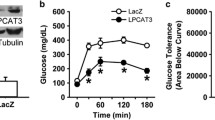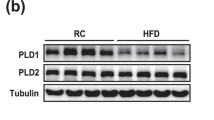Abstract
It has been demonstrated in transgenic mice that the overexpression of human phospholipase A2 group IIA (sPLA2), an acute-phase reactant, is associated with depressed plasma cholesterol levels, altered lipoprotein compositions, and increased lipid depositions in aortic walls. It was the aim of the present study to investigate whether the reduced plasma cholesterol levels in sPLA2-transgenic mice may be due to an increased transfer of lipids from sPLA2-modified lipoproteins to the liver and/or other nonvascular tissues. Ten sPLA2-transgenic mice and an equal number of nontransgenic littermates were fed a cholesterol-enriched (1%) diet for 13 weeks. After autopsy, cholesterol and triglyceride concentrations were measured in homogenates of liver, spleen, kidney, and myocardial tissues. Compared to the nontransgenic controls, the sPLA2-transgenic mice exhibited signi- ficantly lower plasma cholesterol levels, which was due to a reduction in both HDL and β-lipoprotein (LDL+β-VLDL) cholesterol. Liver tissues from the transgenic mice were found to contain signi- ficantly increased concentrations of free and esterified cholesterol, which was not associated with increased triglyceride concentrations. Spleen, kidney, and heart tissues of the two animal groups showed no significant differences in cholesterol or triglyceride concentrations. The findings suggest that the overexpression of human secretory phospholipase A2 group IIA leads to an enhanced delivery of cholesterol from phospholipolysed lipoproteins to the liver. This mechanism is likely to contribute to the development of hypocholesterolemia observed in patients with inflammatory diseases.
Similar content being viewed by others
References
Six, D. A. and E. A. D Ennis. 2000. The expanding superfamily of phospholipase A2 enzymes: Classification and characterization. Biochim. Biophys. Acta 1488:1-19.
Capper, E. A. and L. A. M Arshall. 2001. Mammalian phospholipases A2: Mediators of inflammation, proliferation and apoptosis. Prog. Lipid Res. 40:167-197.
Crowl, R. M., T. J. Stoller, R. R. Conroy, and C. R. Stoner. 1991. Induction of phospholipase A2 gene expression in human hepatoma cells by mediators of the acute phase response. J. Biol. Chem. 266:2647-2651.
Ogawa, M., H. Arakawa, S. Yamashita, K. Sukamoto, and S. Ikeri. 1992. Postoperative elevations of serum interleukin 6 and group II phospholipase A2: Group II phospholipase A2 in serum is an acute phase reactant. Res. Commun. Chem. Pathol. Pharmacol. 75:109-115.
Nevalainen, T. J. 1993. Serum phospholipases A2 in inflammatory diseases. Clin. Chem. 39:2453-2459.
Menschikowski, M., M. Kasper, P. Lattke, A. Schiering, S. Schiefer, H. Stockinger, and W. Jaross. 1995. Secretory group-II phospholipase A2 in human atherosclerotic plaques. Atherosclerosis 118:173-181.
Bobryshev., Y. V., J. A. Crozier, R. S. A. Lord, D. Tran, O. S. Jamal, H. N. Pärsson, and K. F. scott. 1996. Expression of secretory group II phospholipase A2 by CD1a positive cells in human atherosclerotic plaques. Atherosclerosis 127:283-285.
Hurt-Camejo, E., S. Andersen, R. Standal, B. Rosengren, P. Sartipy, E. Stadberg, and B. Johansen. 1997. Localization of nonpancreatic secretory phospholipase A2 in normal and atherosclerotic arteries. Activity of the isolated enzyme on low-density lipoproteins. Arterioscler. Thromb. Vasc. Biol. 17:300-309.
Schäfer Elinder, L., A. Dumitrescu, P. Larsson, U. Hedin, J. Frostegård, and H.-E. Claesson. 1997. Expression of phospholipase A2 isoforms in human normal and atherosclerotic arterial wall. Arterioscler. Thromb. Vasc. Biol. 17:2257-2263.
Romano, M., E. Romano, S. Björkerud, and E. Hurt-Camejo. 1998. Ultrastructural localization of secretory type II phospholipase A2 in atherosclerotic and nonatherosclerotic regions of human arteries. Arterioscler. Thromb. Vasc. Biol. 18:519-525.
Eckey, R., M. Menschikowski, P. Lattke, and W. Jaross. 1997. Minimal oxidation and storage of low density lipoproteins result in an increased susceptibility to phospholipid hydrolysis by phospholipase A2. Atherosclerosis 132:165-176.
Pruzanski, W., E. Stefanski, F. C. De Beer, M. C. De Beer, P. Vadas, A. Ravandi, and A. Kuksis. 1998. Lipoproteins are substrates for human secretory group IIA phospholipase A2: Preferential hydrolysis of acute phase HDL. J. Lipid Res. 39:2150-2160.
Kleinman, Y., E. S. Krul, M. Burnes, W. Aronson, B. Pfleger, and G. Schonfeld. 1988. Lipolysis of LDL with phospholipase A2 alters the expression of selected apoB-100 epitopes and the interaction of LDL with cells. J. Lipid Res. 29:729-743.
Menschikowski, M., U. Hempel, G. Dinnebier, P. Lattke, K. W. Wenzel, and W. Jaross. 1995. Changes in epitope exposition of apolipoprotein A-I on the surface of high density lipoproteins after phospholipase A2 treatment. Atherosclerosis 117:159-167.
Gorshkova, I. N., M. Menschikowski, and W. Jaross. 1996. Alterations in the physicochemical characteristics of low and high density lipoproteins after lipolysis with phospholipase A2. A spin label study. Biochim. Biophys. Acta 1300:103-113.
Korotaeva, A. A., N. K. Golovanova, T. N. Vlasik, E. V. Yanushevskaya, V. P. Tsibulsky, V. V. Yakushkin, M. G. Tvorogova, A. D. Morozkin, and N. V. Prokazova. 1998. Immunoreactivity of apolipoprotein B-100 and binding to LDL-receptor of phospholipase A2-treated low density lipoproteins. Biochem. (Moscow) 63:1430-1437.
Sartipy, P., G. Camejo, L. Svensson, and E. Hurt-Camejo. 1999. Phospholipase A2 modification of low density lipoproteins forms small high density particles with increased affinity for proteoglycans and glycosaminoglycans. J. Biol. Chem. 274:25913-25920.
Aviram, M. and I. Maor. 1992. Phospholipase A2-modified LDL is taken up at enhanced rate by macrophages. Biochim. Biophys. Res. Commun. 185:465-472.
Menschikowski, M., P. Lattke, S. Bergmann, and W. Jaross. 1995. Exposure of macrophages to PLA2-modified lipoproteins leads to cellular lipid accumulations. Anal. Cell. Pathol. 9:113-121.
Bamberger, M., J. M. Glick, and G. H. Rothblat. 1983. Hepatic lipase stimulates the uptake of high density lipoprotein cholesterol by hepatoma cells. J. Lipid Res. 24:869-876.
Bamberger, M., S. Lund-Katz, M. C. Phillips, and G. H. Rothblat. 1985. Mechanism of the hepatic lipase induced accumulation of high-density lipoprotein cholesterol by cells in culture. Biochemistry 24:3693-3701.
Collet, X., B.-P. Perret, G. Simard, C. Vieu, and L. Douste-Blazy. 1990. Behaviourof phospholipase-modified HDL towards cultured hepatocyte s. I. Enhanced transfer of HDL sterols and apoproteins. Biochim. Biophys. Acta 1043:301-310.
De Beer, F. C., M. C. De>Beer, D. R. Van Der Westhuyzen, L. W. Castellani, A. J. Lusis, M. E. Swanson, and D. S. Grass. 1997. Secretory non-pancreatic phospholipase A2: Influence on lipoprotein metabolism. J. Lipid Res. 38:2232-2239.
Menschikowski, M., R. Eckey, J. Pietzsch, J. Aufenanger, R. Kumpf, P. Nelz, and W. Jaross. 2000. Expression of human secretory group IIA phospholipase A2 is associated with reduced concentrations of plasma cholesterol in transgenic mice. Inflammation 24:227-237.
Ivandic, B., L. W. Castellani, X.-P. Wang, J.-H. Qiao, M. Mehrabian, M. Navab, A. M. Fogelman, D. S. Grass, M. E. Swanson, M. C. De Beer, F. C. De Beer, and A. J. Lusis. 1999. Role of group II secretory phospholipase A2 in atherosclerosis. 1. Increased atherogenesis and altered lipoproteins in transgenic mice expressing group IIA phospholipase A2. Arterioscler. Thromb. Vasc. Biol. 19:1284-1290.
Labeque, R., C. J. P. Mullon, J. P. M., Ferreira, R. S. Lees, and R. Langer. 1993. Enzymatic modification of plasma low density lipoproteins in rabbits: A potential treatment for hypercholesterolemia. Proc. Natl. Acad. Sci. U.S.A. 90:3476-3480.
Tiedtge, U. J. F., C. Maugeais, W. Cain, D. Grass, J. M. Glick, F. C. De Beer, and D. J. Rader. 2000. Overexpression of secretory phospholipase A2 causes rapid catabolism and altered tissue uptake of high density lipoprotein cholesteryl ester and apolipoprotein A-I. J. Biol. Chem. 275:10077-10084.
Grass, D. S., R. H. Felkner, M. Y. Chiang, R. E. Wallace, T. J. Nevalainen, C. F. Bennett, and M. E. Swanson. 1996. Expression of human group II PLA2 in transgenic mice results in epidermal hyperplasia in the absence of inflammatory infiltrate. J. Clin. Invest. 97:2233-2241.
Nevalainen, T. J., V. J. O. Laine, and D. S. Grass. 1997. Expression of human group II phospholipase A2 in transgenic mice.J. Histochem. Cytochem. 45:1109-1119.
Fox, N., M. Song, J. Schremeti, J. D. Sharp, D. L. White, D. W Snyder, L. W. Hartley, D. G. Carlson, N. J. Bach, R. D. Dillard, S. E. Draheim, J. L. Bobbitt, L. Fisher, and E. D. Mihelich. 1996. Transgenic model for the discovery of novel human secretory non-pancreatic phospholipase A2 inhibitors. Eur. J. Pharmacol. 308:195-203.
Kennedy, B. P., P. Payette, J. Mudgett, P. Vadas, W. Pruzanski, M. Kwan, C. Tang, D. E. Rancourt, and W. A. Cromlish. 1995. A natural disruption of the secretory group II phospholipase A2 gene in inbred mouse strains. J. Biol. Chem. 270:22378-22385.
Aufenanger, J., W. Zimmer, and R. Katterman. 1993. Characteristics and clinical application of a radiometric Escherichia coli-based phospholipase A2 assay modified for serum analysis. Clin. Chem. 39:605-613.
Aufenanger, J., P. Haux, and R. Kattermann. 1989. Improved method for enzymic determination of cholesterol in lipoproteins seperated by electrophoresis on thin layer agarose gels. J. Chem. Clin. Biochem. 27:807-813.
Macart, M. and L. Gerbaut. 1982. An improvement of the Coomassie Blue dye binding method allowing an equal sensitivity to various proteins: Application to cerebrospinal fluid. Clin. Chim. Acta 122:93-101.
Vercaemst, R., A. Union, M. Rosseneu, I. De Craene, G. De Backer, and M. Kornitzer. 1989. Quantitation of plasma free cholesterol and cholesteryl esters by high performance liquid chromatography. Atherosclerosis 78:245-250.
Keffer, J., L. Probert, H. Cazlaris, S. Georgopoulos, E. Kaslaris, D. Kioussis, and G. Kollias. 1991. Transgenic mice expressing human tumour necrosis factor: A predictive genetic model of arthritis. EMBO J. 10:4025-4031.
Hack, C. E., G.-J. Wolbink, C. Schalkwijk, H. Speijer, W. T. Hermens, and H. Van Den Bosch. 1997. A role for secretory phospholipase A2 and C-reactive protein in the removal of injured cells. Immunol. Today 18:111-115.
Wilson, D. E., G. R. Birchfield, J. S. Hejazi, J. H. Ward, and W. E. Samlowski. 1989. Hypocholesterolemia in patients treated with recombinant interleukin-2: Appearance of remnant-like lipoproteins. J. Clin. Oncol. 7:1573-1577.
Grove, R. J., C. Mazzucco, N. Allegretto, P. A. Kiener, G. Spitalny, S. F. Radka, M. Shoyab, M. Antonaccio, and G. A. Warr. 1991. Macrophage-derived factors increase low-density-lipoprotein uptake and receptor number in cultured human liver cells. J. Lipid Res. 32:1889-1897.
Ettinger, W. H., L. D. Miller, J. J. Albers, T. K. Smith, and J. S. Parks. 1990. Lipopolysaccharide and tumor necrosis factor cause a fall in plasma concentration of lecithin: Cholesterol acyltransferase in cynomolgus monkeys. J. Lipid Res. 31:1099-1108.
Ettinger, W. H., V. K. Varma, M. Scorci-Thomas, J. S. Parks, R. C. Sigmon, T. K. Smith, and R. B. Verdery. 1994. Cytokines decrease apolipo protein accumulation in medium from HepG2 cells. Arterioscler. Thromb. 14:8-13.
Author information
Authors and Affiliations
Corresponding author
Rights and permissions
About this article
Cite this article
Eckey, R., Menschikowski, M., Lattke, P. et al. Increased Hepatic Cholesterol Accumulation in Transgenic Mice Overexpressing Human Secretory Phospholipase A2 Group IIA. Inflammation 28, 59–65 (2004). https://doi.org/10.1023/B:IFLA.0000033021.44105.9c
Issue Date:
DOI: https://doi.org/10.1023/B:IFLA.0000033021.44105.9c




